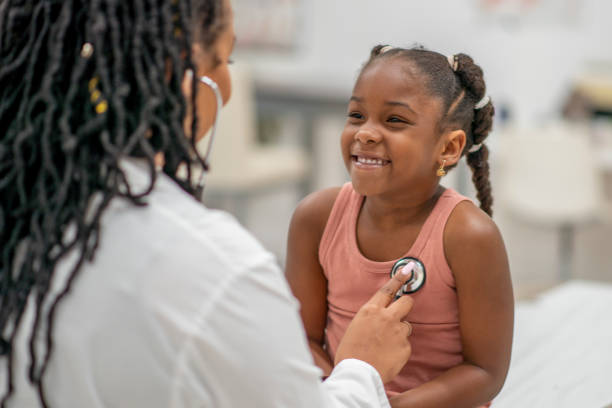
Eye Examinations
Vision screening is a crucial component of pediatric healthcare aimed at identifying visual impairments or eye conditions early in children to facilitate timely intervention and prevent long-term complications. At SHIFAA PAN African Hospitals, our Ophthalmology Department provides comprehensive vision screening services using state-of-the-art equipment and expertise, ensuring optimal visual health for children of all ages.
Procedure:
- Patient History: The eye examination typically begins with a detailed review of the child’s medical history, including any family history of eye conditions, previous eye surgeries, or vision-related complaints.
- Visual Acuity Testing: Visual acuity is assessed using age-appropriate methods, such as Snellen charts, tumbling E charts, or picture charts. The child is asked to identify letters, numbers, or symbols at varying distances to evaluate their ability to see clearly.
- Refraction Assessment: Refractive errors, such as nearsightedness, farsightedness, and astigmatism, are evaluated using techniques like retinoscopy, autorefraction, or subjective refraction to determine the need for corrective lenses.
- Binocular Vision Evaluation: Binocular vision, including eye alignment, convergence, stereopsis (depth perception), and eye teaming, is assessed to detect any abnormalities or signs of strabismus (eye misalignment).
- Ocular Health Examination: The external and internal structures of the eyes are examined using a handheld ophthalmoscope or slit lamp biomicroscope to assess eye health and detect any signs of abnormalities, such as cataracts, glaucoma, retinal disorders, or other ocular conditions.
- Additional Testing: Depending on the child’s age, medical history, and presenting symptoms, additional tests may be performed, such as intraocular pressure measurement (tonometry), visual field testing, color vision testing, or corneal topography.
Indications:
Eye examinations are recommended for all children at regular intervals as part of routine pediatric healthcare visits. They are especially important for:
- Newborns and infants to detect congenital eye abnormalities or conditions.
- Preschool-aged children to identify amblyopia (lazy eye), strabismus, or refractive errors that can affect visual development.
- School-aged children to detect vision problems that may interfere with learning or academic performance.
Benefits:
- Early detection and intervention for vision problems can prevent or minimize long-term visual impairments and associated complications.
- Improved academic performance and quality of life for children with corrected vision.
- Enhanced safety and independence in daily activities, such as reading, writing, and participating in sports or recreational activities.
Preventive Measures:
In addition to regular eye examinations, parents and caregivers can promote good eye health in children by:
- Encouraging healthy lifestyle habits, such as eating a balanced diet rich in nutrients that support eye health, getting regular exercise, and minimizing screen time.
- Providing adequate eye protection during outdoor activities or sports to reduce the risk of eye injuries.
- Practicing proper eye hygiene and safety measures, such as wearing sunglasses with UV protection, avoiding exposure to harmful chemicals or pollutants, and using protective eyewear when necessary.
When should my child have their first eye examination?
The American Academy of Ophthalmology recommends that children undergo their first comprehensive eye examination at around six months of age, followed by subsequent exams at regular intervals as recommended by their pediatrician or eye care provider.
What are the signs that my child may need an eye examination?
Signs that may indicate the need for an eye examination include squinting, frequent eye rubbing, holding objects close to the face, excessive tearing, complaints of headaches or eye strain, or difficulty focusing on near or distant objects.
How long does an eye examination take for a child?
The duration of an eye examination for a child may vary depending on factors such as the child’s age, cooperation, and any additional tests or procedures that may be required. On average, a comprehensive eye examination can take 30 to 60 minutes.
What if my child needs corrective lenses?
If refractive errors are detected during the eye examination, your eye care provider will prescribe corrective lenses (eyeglasses or contact lenses) to help your child see more clearly and comfortably. Regular follow-up visits may be recommended to monitor visual changes and adjust prescriptions as needed.
By offering comprehensive eye examinations, our Ophthalmology Department at SHIFAA PAN African Hospitals aims to safeguard the visual health and well-being of children, ensuring early detection and intervention for optimal visual outcomes.
Pediatrics Procedures
- Barium Enema
- Barium Swallow
- Blood Tests
- Blood Transfusion
- Bone Marrow Aspiration and Biopsy
- Circumcision
- Corrective Surgeries for Congenital Anomalies
- Echocardiography
- EEG (Electroencephalogram)
- Eye Examinations
- Hernia Repair
- Holter Monitoring
- Imaging (X-rays, Ultrasound, MRI)
- Lumbar Puncture
- Nebulizer Treatments
- Pulmonary Function Tests (PFTs)
- Respiratory Procedures
- Tonsillectomy and Adenoidectomy
- Upper and Lower Endoscopy
- Vision Screening




